
Powered by intellect, driven by passion
Text & pics: Veejay Sai
e-mail: vs.veejaysai@gmail.com
September 7, 2015
There are two sides to this story. One, often told by the dancer and the
other, less heard, by the dance itself. The dancer’s version has
changed over the decades. From a philosophy to a tantrum, the story of
the Varnam has traveled stage to stage, mouth to mouth, whisper to
gossip and guru to shishya. What is it about this one piece, acting like
a fulcrum in a Margam, that keeps one still awed about its everything
in a Bharatanatyam performance? What is it about the Varnam that can
claim your undivided attention, though it has been performed for the Nth
time? The content? The lyrics? The music that carries them? The
antiquity of the composition? The nritta where the dancer can exhibit
virtuosity? The underlying philosophy? All of them together? Or some
sheer madness by a possessed dancer to perform this again and again ad
nauseum!
The two day festival-cum-seminar-cum-vidwat sabha organized on August 24
and 25 to celebrate twenty years of Spanda Dance Company by Leela
Samson in Chennai was one of the finest festivals done in this decade.
Over two days, a packed Sivagami Pethachi Auditorium witnessed
performances by four veterans of Bharatanatyam. More than a festival it
was a vidwat sabha!
The first day’s performances began with a lecture-demonstration by, who
could be easily the world’s oldest male Bharatanatyam dancer, veteran
Guru C V Chandrasekhar. He presented the Thanjavur Quartet varnam
‘Sarojaakshiro’, a Swarajathi set to ragam Yadukula Kamboji. For someone
who announced he was dancing from the age of ten, he said it was still a
challenge. Reminiscing his early days in Kalakshetra, CVC said how he
was given this composition as an exam by Sarada teacher. Using his own
sense of choreography, he introduced rhythmic components like keeping
the charanam in trisra gati adi talam and so forth. While CVC performed
the sancharis where the abhinayam was required, his students, the
dancer-couple Renjith Babu and Vijna Vasudevan performed the nritta
sequences. What a divine sight! At 80 plus, CVC could give men half his
age a run for their money! Portraying a nayika while not once catering
to the stereotyped perception that men need to ‘behave’ feminine or put
on any such mannerisms, he performed every line in great detail.
The fact that it was a male performing a nayika, paled into
insignificance. If anyone remembers how good old Kelu Babu performed
Radha, the sakhi, even many sakhis and told us stories from the Gita
Govindam, without once ever taking on feminine mannerisms, CVC’s
performance was just that! In the second half as he performed a perfect
thattu-mettu, the house came down with a large round of applause. Even a
stunned veteran musician Vedavalli fell short of words in praising him.
She pointed out how it was important to know when and where to pause
and when to dance in the course of the composition. The kaalapramanam
has to be kept in mind giving the foremost importance to sahityam.
There was no great story telling in CVC’s presentation. Just old-world
charm and sophistication. Abhinayam takes on different shades and here
was a presentation overflowing with a sense of ‘saathvikam’. One got to
see CVC’s mastery not only in performance but pace to and fro in-between
to render the nattuvangam, not once missing a beat! If every male
Bharatanatyam dancer aspires to be like CVC and reaches even the half
mark up there, they would have achieved a lot in their careers!
From there to the second presentation of the evening, Nandini Ramani
took us through a lecture-demonstration of ‘Sarasijakshudu’, the
Thanjavur Quartet varnam written by Sivanandam set to ragam Kalyani. She
spoke of how the varnam came down as an oral tradition among nattuvanar
families. Recollecting her memories with her guru, the great
Balasaraswati and her mother Jayammal, Nandini spoke of how they saw
this varnam. While the varnam is fairly known, the technical aspects of
their style, like following the sequence in jatis, was like a signature.
The order was always Chatusram, Trisram, Misram, Khandam and Sankeernam
and this never changed. This was also to establish the strong sthayi
bhavam of the whole composition vis a vis its nritta and abhinayam. The
thattu-mettu was always from the mukthaai part of the composition.
Nandini mentioned the spontaneity of abhinayam that came with the Bala
school of performing where nothing was over-dramatized or elongated into
stories.
In her second piece ‘Maa Mohalahiri’ written by Namashivaya Pulavar
taken from Valli Bharatam set to ragam Khamas and roopaka talam,
Nandini’s scholarly avatar was seen. It isn’t for no reason that she is
the daughter of the great V. Raghavan, in addition to being a student of
Balamma! In her explanation of the piece, she mentioned how the dhaatu
set by Subbarama Dikshitar according to the Sangita Sampradaya
Pradarshini, one finds much detailing about this less-performed
composition. Speaking about the technical details of the piece, Nandini
showed how the edippu was in trisram, how the swaraakshara passages in
‘maa paa dha maa’ came in madhyamam and the swara refrain in the
charanam was in yet another sequence. This way how the composition
blossomed into the story of the nayika’s pining and love for lord Muruga
was a journey Nandini explained through the lecture -demonstration.
Nandini spoke of those times when gurus taught each varnam with much
patience and it would take a student at least six months to learn one
and longer to master it! This must register with today’s generation of
dancers who learn or go varnam-window-shopping along with their
Guru-hopping!
The session ended with a fine presentation about the Brihadeeshwara
temple by Chitra Madhavan. Explaining some of the famous sculptures in
the temple, the murals inside the temple and the fascinating history,
Chitra took us down memory lane. Dancers must make a field trip with
often soft spoken and reticent Chitra to Thanjavur and get more out of
her! She is a mine of information waiting to be explored!
Slide show
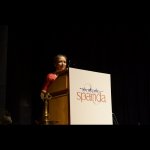
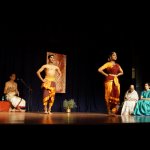
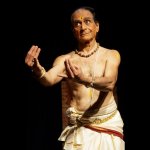

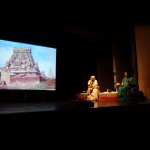
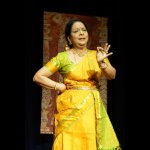
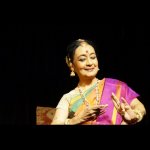
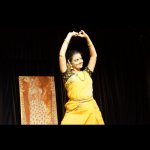
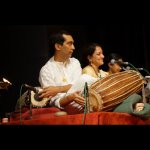
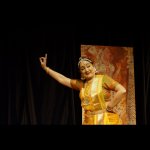
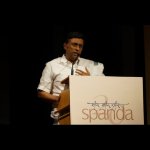
The second day began with the presentation of Sudharani Raghupathy. At
this point it is important to say how she is one of the least tapped and
original sources of some of the best abhinayam one could possibly see
in Bharatanatyam. Even within Chennai, her performances are scarce. So
watching her perform was like re-visiting a fine old recording of Swan
Lake, or even better. In her presentation of the famous Thanjavur
Quartet Ragamalika varnam ‘Saami Ninne Kori’, she announced elegantly
how she would perform what could be the ‘fulcrum’ of the whole piece,
the ‘kalayara’ bit. She pointed out the importance of the ‘Ashtottaram’
in the ‘Padaartha’ and ‘Vyaakyaartha’ in the varnam. Within the
choreography of the piece, she mentioned and performed how the nayika
finds herself small in comparison to the great lord and in this case the
physically large structure of Brihadeeshwara. The nayika’s sense of
longing comes forth in the lines ‘Biraana nannelukora Brihadeeshwara.’
While Sudharani performed the abhinayam and sanchari bits, her student
T.M. Sridevi, with a pleasant demeanor did the nritta sequences.
Sudharani spoke of how she met her guru Kittappa Pillai for the first
time when she was a five year old kid. How he made her practice the
Navasandhi Kauthuvams, observe the Arayer Sevai and other rituals way
back in 1957! Getting into the technical aspects of the composition, she
mentioned how the theermanams were mostly in four avartanams, including
the Pallavi section. The usage of ‘Uthpluta’ or leaps within the
movement was probably choreographed on her for the first time.
In her presentation of the famous Husseini Swarajati ‘Ye mandayaana
raa’, one got glimpses of Sudharani’s excellent abhinayam. Portraying
the scorned nayika, her involvement and spontaneity captured the essence
of the piece. Her health wasn’t in the best of shape and she had to cut
short her presentation. But one can imagine what Sudharani might have
danced like in her prime! Even now, she is one of the finest exponents
of abhinayam. Why haven’t sabhas, organizations, festival curators not
tapped her potential more? Especially in these times when just about
everyone is cloning the other in abhinayam! Her son K.S.R. Aniruddha’s
mridangam accompaniment was a delight to listen to. He is easily one of
the finest mridangam vidwans we have today on the scene, in fact far
better than most of those who play for Carnatic kacheris. Crisp and
concise, Sudharani’s presentation had a long-lasting effect, like a
quick waft of perfume that lingers on.
The last presentation of the festival was by the one and only Lakshmi
Vishwanathan. Articulate, engaging, a wonderful sense of humor and
insightful, Lakshmi’s lecture-demonstration was like a satisfying
dessert after the large Spanda buffet. She performed two pieces. One
more rare than the other on today’s dance scene. The first one was the
lesser known and even less performed (in today’s times) varnam ‘Daanike
tagu jaanara’ set to ragam Todi by Sivanandam of the Thanjavur Quartet.
Lakshmi began by detailing how she kept encountering ragam Todi in her
life. From her childhood music lessons with vidwans T. Narayanaswamy and
T. Krishnamurty and dance classes with the great Kanchipuram Ellappa
Pillai to listening to the 78 RPM records of T.N. Rajarathnam Pillai
perform Todi, she literally ‘journeyed’ with Todi. She said it was
important to live with the mood of the ragam, long enough to bring it
out naturally in one’s dance performance at any point. The raga bhavam
was extremely important to bring out in dance. She remarked that though
the Thanjavur Quartet wrote lyrics in Telugu, which were of no great
poetic quality, they made sure the ‘rasa’, in this case shringaram, was
highlighted effortlessly. The varnam as such was written in praise of
king Shivaji and not for any god. There was no question of the fairly
recent theory of ‘jeevatma-paramatma’ masking on to the whole
composition.
Now this was a big insight into learning a varnam. In today’s times when
Guru-hopping is in vogue, one wonders if students of dance ever think
of how important the knowledge of a ragam is. Do they value in investing
time learning music before thinking of ‘hoarding’ ‘items’, which they
can perform? Worse, those who learn from watching DVDs!
The second one Lakshmi presented was the famous ata tala varnam
‘Viriboni’ composed by Pachchimiriam Adi Appiah. She said while the
lyrics of the composition were very basic, it was important to bring out
the raga bhaavam of the varnam. Once again it was important to have
journeyed with the ragam till one arrived at a comfort zone, enough to
perform it in dance. From the very basic attami in the opening sequence
to the more complicated usage of trisram, a clear change in the talam
pattern, in the charanam, Lakshmi detailed the varnam with grace.
This was followed by a small presentation on the famous Rajagopala
temple in Mannargudi, incidentally the deity being addressed to in the
Viriboni varnam. Being one of the largest temple complexes spread over
twenty- five acres on the banks of the Haridra river, the temple is a
lesser-visited destination among others in the rich Thanjavur
district. With her inputs and detailed explanations paired with
slides, historian and scholar Chitra Madhavan gave us a wonderful visual
treat. The icing on the cake was vidwan Sanjay Subrahmanyan’s scholarly
commentary at the end of the session. Agreeing that most varnams were a
window into the past, he said that Carnatic music must have surely
borrowed these from dance. He also mentioned how Padavarnams lent
themselves towards dance and Taana Varnams were better for music. One
could have heard Sanjay go on about the fine intricacies of the musical
side of these compositions. In fact, this coming December when he will
be honoured with the prestigious Sangita Kalanidhi award, dancers must
make it a point to attend the morning vidwat sabha (the lecture
demonstrations) in the Music Academy to listen to more of Sanjay. This
is a golden opportunity for dancers who want to expand their knowledge
of music.
There are very few festivals where you feel they ended too soon. This
was one such! From simple and elegant stage aesthetics to the
presentations of these veterans, celebrating Spanda at their twentieth
birthday was historic. It was easily one of the best festivals curated
around Bharatanatyam in this decade. If every other dance form, like
Kuchipudi could follow this module, there might be good chances of
salvaging what is left. Towards the end of the festival, dancer Priya
Murle came and slowly whispered, “Move over stars, the legends are
here!” How true! Every generation of dancers need their heroes to look
up to. These four veterans are living archives of their respective
traditions. The more one can get out of them, the better for the course
of the dance form. Thanks to this festival, a whole generation of young
dancers, dance enthusiasts and rasikas got to witness some vintage
varnams, some excellent performances and some food for thought. This
will remain an experience worth cherishing. Thank you Spanda and thank
you Leela Samson for putting together this excellent festival! More
power to you!
Veejay Sai is a writer, editor and a culture critic.
|

